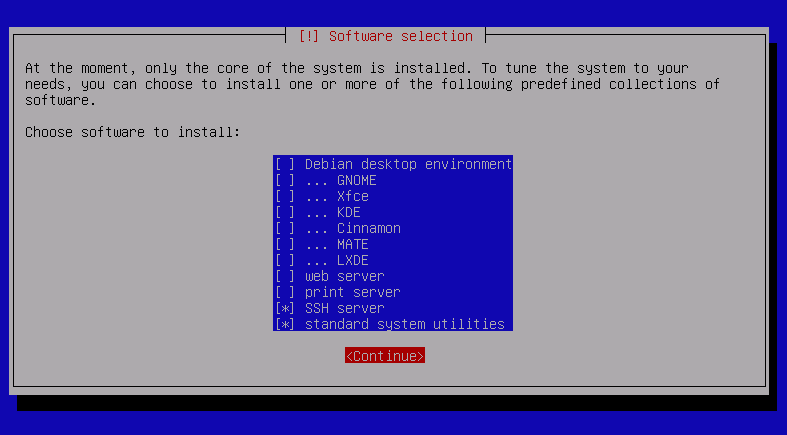Start with the network install or “netinst” image to install the operating system. This image contains just the minimal amount of software to start the installation and fetch the remaining packages over the internet. I’m using the 64 bit installation media (debian-9.5.0-amd64-netinst.iso).
Work through the installation process to install the Debian base system. The graphical installer is a straightforward process. At the software selection screen disable the Debian Desktop Environment, select the SSH Server and Standard System Utilities.

Installing Symbiosis on a fresh Stretch system is simple. First add curl to your Debian 9 machine:
apt-get install curl
Add the Bytemark package signing key:
curl -sSL https://secure.bytemark.co.uk/key/repositories-2014.key | apt-key add -

Next add the following to /etc/apt/sources.list.d/symbiosis.list :
# # Bytemark Symbiosis Packages # deb http://symbiosis.bytemark.co.uk/stretch/ ./ deb-src http://symbiosis.bytemark.co.uk/stretch/ ./
Check that update-inetd is installed (not part of the process normally,however, the installation failed once because this was missing on a Digital Ocean Droplet):
apt-get install update-inetd
Once you’ve done the above install Symbiosis:
apt-get update apt-get install --install-recommends bytemark-symbiosis
Reboot the system and login as the admin user. Run sudo symbiosis-monit –verbose to check the status of installed services.
With Server Name Indication (SNI) browsers can indicate to a server which virtual host they are connecting to, even with SSL. Adding a SSL does not require a fixed IP address. This helps reduce IPv4 requirements considerably as we approach IPv4 exhaustion. It can also help mitigate the impact of future server migrations.
To use SNI decide if you want all sites to use a single (primary) IP address or separate some sites on a secondary address.
Most Symbiosis configurations (for example, small cloud servers or local development machines) will use a single primary IP address. To use the primary address you need to turn off “mass hosting” by creating a file disabled.zz-mass-hosting .
/etc/symbiosis/apache.d/disabled.zz-mass-hosting
Force Symbiosis to update its configuration by running sudo symbiosis-httpd-configure –verbose or wait for the hourly cron to run.
To prevent accidental lock-out add your IP address to the whitelist:
/etc/symbiosis/firewall/whitelist.d/aaa.bbb.ccc.ddd
Allow sites to make outgoing connections. You can remove the 50-reject-www-data file or add a list of allowed sites:
/etc/symbiosis/firewall/outgoing.d/50-reject-www-data
Take the webalizer directory out of htdocs by editing the by /srv/mydomain.com/config/webalizer.conf .
